7 Steps To Create An Employee Attendance Improvement Plan

Having an employee attendance plan is really important for companies to run smoothly. A good plan to improve attendance is key to dealing with absenteeism problems early.
Looking for an action plan? Click here to jump directly to our “7-step process” to develop a solid employee attendance improvement plan! 💪
When expectations and consequences for attendance are clear, employees understand why being present and on time matters. It helps create a culture where employees feel responsible and dependable.
The top three things a good attendance improvement plan helps with for both employers and employees are,
- Improved Productivity: A good plan helps employers ensure they have enough staff to handle the work.
- Better Employee Morale: When some employees are often absent, it can frustrate others because they have to do more work.
- Cost Savings: Too much absenteeism can cost companies a lot of money, like paying overtime, hiring temporary workers, and losing productivity.
Try Buddy Punch For Free
| What is the Employee Attendance Improvement Plan? |
| The employee attendance improvement plan (EAIP) is a structured program to help employees get better at coming to work on time. It’s usually used when an employee has too many absences or is often late. The EAIP gives a plan for dealing with attendance problems, with the goal of improving attendance and creating a better work environment for everyone. |
Why Do You Need an Employee Attendance Improvement Plan?

An Employee Attendance Improvement Plan (EAIP) helps employees understand the importance of being present at work consistently.
Here’s why:
- Clarity: It provides clear expectations for attendance.
- Feedback: Helps employees understand how their attendance affects their performance.
- Support: Offers support and resources for overcoming attendance challenges.
- Accountability: Holds employees accountable for their attendance.
- Legal Compliance: Ensures compliance with company policies and labor laws.
- Productivity: Improves overall productivity and team morale.
How to Create an Employee Attendance Improvement Plan?

Following are the 7 simple steps you can take to create an employee attendance improvement plan for your employees.
1. Identify the Issue
The first step in making a plan to improve employee attendance is to figure out exactly what the attendance problems are.
This means keeping track of and writing down when the employee is late, doesn’t show up without a good reason, or has a habit of missing work.
2. Meet With the Employee
After figuring out the attendance problems and why they’re happening, the next step in making a plan to improve employee attendance is to talk to the employee.
This meeting should be private and friendly, focusing on finding ways to fix the issues instead of pointing fingers.
3. Discuss Consequences
As you create a plan to improve employee attendance, it’s important to discuss what might happen if attendance doesn’t improve.
This discussion should be done professionally and with understanding, stressing how attendance matters for the employee’s job and the success of the company.
4. Develop a Plan Together
Start by setting clear, measurable, achievable, relevant, and time-bound (SMART) attendance goals for improving attendance.
Then, write down the strategies and actions that will be used to help the employee meet these goals.
This might include offering flexible work options, providing more training or help, or dealing with any underlying issues causing the attendance problems.
5. Identify Supportive Measures
Supportive measures could involve flexible work options, like working from home, to fit the employee needs and schedule.
Providing access to employee assistance programs (EAPs) can give employees resources and support for personal or health issues that might be causing their attendance problems.
6. Document the Plan
After creating the Employee Attendance Improvement Plan (EAIP) with the employee, it’s important to write it down.
This written plan is a reference for both the employee and the employer, ensuring everyone understands what’s expected and what actions will be taken.
The written plan should include:
- Attendance Improvement Goals: Clearly explain the specific goals for improving attendance that have been agreed upon.
- Supportive Measures: Describe the help that will be given to help the employee improve attendance, like flexible work options or access to EAPs.
- Consequences: Explain what will happen if the attendance goals aren’t met, including any disciplinary steps that might be taken.
- Timeline: Set a schedule for reviewing and checking the employee’s progress toward meeting the attendance goals.
7. Follow Up Regularly
Regular check-ins help ensure the employee stay dedicated to improving their attendance and allow for quick action if any problems arise.
During these check-ins, look at the employee’s attendance record and see how it compares to the goals in the EAIP.
Celebrate any improvements in attendance, and talk about any issues or challenges the employee might be having affecting their attendance.
Ready to give Buddy Punch a try?
For free trial, no credit card required.
How Should Attendance and Punctuality Be Evaluated in Employee Performance Appraisals?
Assessing attendance and punctuality:
- We should measure attendance and being on time in a clear way, like counting how many times someone is absent or late, and how well they stick to their schedule.
- When evaluating job performance, we need to think about how attendance affects the team’s work and how productive everyone is.
- We should also think about whether there are good reasons for missing work or if someone has gotten better at being on time over time.
How Can Employers Effectively Communicate with Employees About Attendance?
Employers can talk clearly, give feedback often, and help when needed. They should set clear rules about attendance, remind everyone why it matters, and keep communication open.
This helps employees know how important it is to be on time and dependable.
What Are Some Appropriate Performance Review Phrases for Addressing Attendance?
- “Consistently demonstrates excellent attendance and punctuality.”
- “Shows dedication by consistently arriving on time and rarely missing work days.”
- “Needs improvement in maintaining regular attendance and punctuality.”
What Comments Should Be Included in an Attendance Review?
Comments should highlight,
- attendance patterns,
- commend good attendance records,
- address any issues impacting attendance,
- and provide constructive suggestions for improvement.
It’s essential to acknowledge efforts made to improve attendance and offer support for overcoming challenges.
What Phrases Can Employers Use to Address Poor Attendance Performance? Effective Employee Attendance Write Up
- “Your consistent tardiness is impacting team productivity.”
- “Your frequent absences have become a concern for the team.”
- “Improvement in attendance is necessary to meet job expectations.”
What Criteria Should Be Used in Attendance Performance Reviews?
Criteria may include,
- frequency of absences,
- tardiness instances,
- adherence to schedule,
- reasons for absences,
- impact on team productivity,
- and improvement over time.
Using a combination of quantitative data and qualitative observations ensures a holistic evaluation.
What Should Employers Include in an Action Plan for Non-Performing Employees?
An action plan should include,
- specific goals for improving attendance,
- strategies for addressing underlying issues,
- support resources available,
- a timeline for improvement,
- and consequences for failing to meet expectations.
Regular check-ins and adjustments to the plan may be necessary to ensure progress.
What Are Some Key Components of an Attendance Improvement Plan Template?

| Component | Description |
| Introduction | An explanation of why we’re creating the plan and why it’s important. |
| Goals/Objectives | Clear goals and targets for improving attendance. |
| Current Attendance Data | Information about how often someone is showing up to work right now. |
| Root Cause Analysis | Figuring out why someone might be missing work, like health or personal issues. |
| Strategies and Interventions | Plans for how we’ll help someone improve their attendance. |
| Support Resources | Listing the ways we can support someone who’s having trouble coming to work. |
| Accountability | Clarifying who’s responsible for what in making sure attendance gets better. |
| Monitoring and Evaluation | How we’ll keep track of progress and see if our plans are working. |
| Timeline | Setting a schedule for when we want to see improvements. |
| Review and Follow-Up | Checking in regularly to see if things are getting better and making changes if needed. |
| Conclusion | Wrapping up the plan and encouraging the person to work on their attendance. |
Is It Necessary to Use An Attendance Tracker Software?
Attendance tracker software can automatically record when employees are at work, making it easier to see patterns of missing work and to check if they’re improving.
It can also give useful information about attendance trends and help determine why employees might not be showing up to work.
So, to answer the question, YES! Using an attendance tracking software is a must if you seriously want to manage your employees’ attendance.
Best Options for Attendance Tracking Software
The following are the best options for attendance tracking software:
1. Buddy Punch
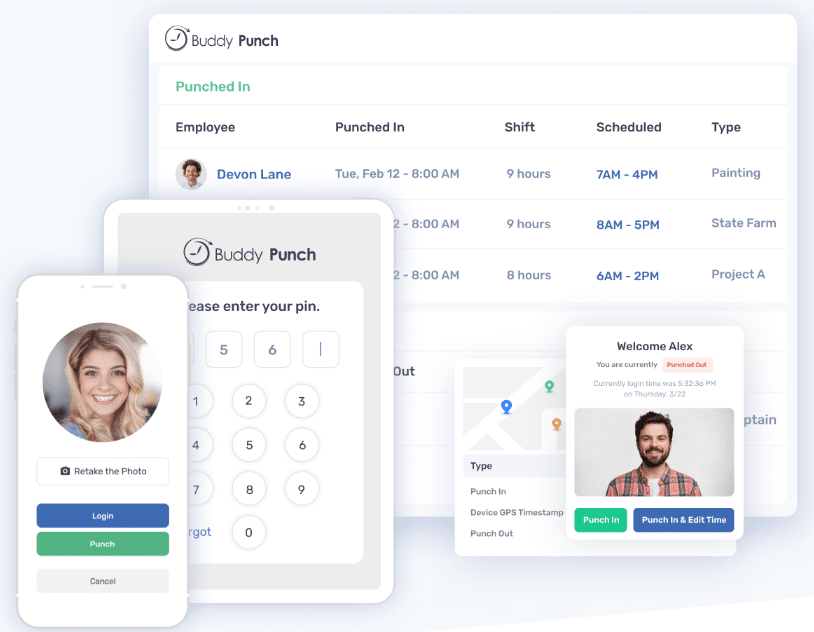
Buddy Punch is a widely used attendance tracking software that businesses of all types and sizes use.
Employees can record when they start and finish work using a web browser (Windows or Mac), mobile app (Android or iOS), or even by calling in, which is handy for workers at the workplace and working from home.
Here are some of a few useful features Buddy Punch has to offer when it comes to effective attendance management.
1. Real-Time Attendance Tracking
Real-time attendance tracking lets every employee’s manager instantly know who is currently working, who is running late, and who has finished work for the day.
This is very useful for planning employee schedules, ensuring enough staff, and dealing with attendance issues quickly.
2. Monitoring Overtime to Ensure Attendance
Buddy Punch has strong tools for tracking overtime, which is important for ensuring employees follow attendance rules.

With Buddy Punch’s reports, managers can quickly see how much overtime each employee has worked.
This helps them understand employee attendance habits and deal with attendance problems before they become serious.
3. Accountability Through GPS tracking and Webcam Images (Facial Recognition)
With Buddy Punch, you can make sure employees are responsible by using GPS tracking and webcam images.
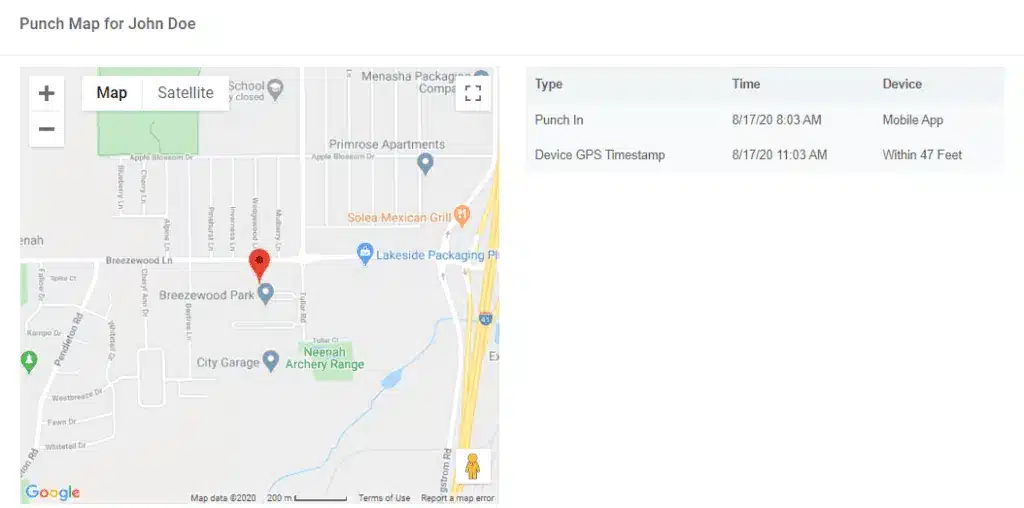
The GPS tracking shows where employees clock in or out live.
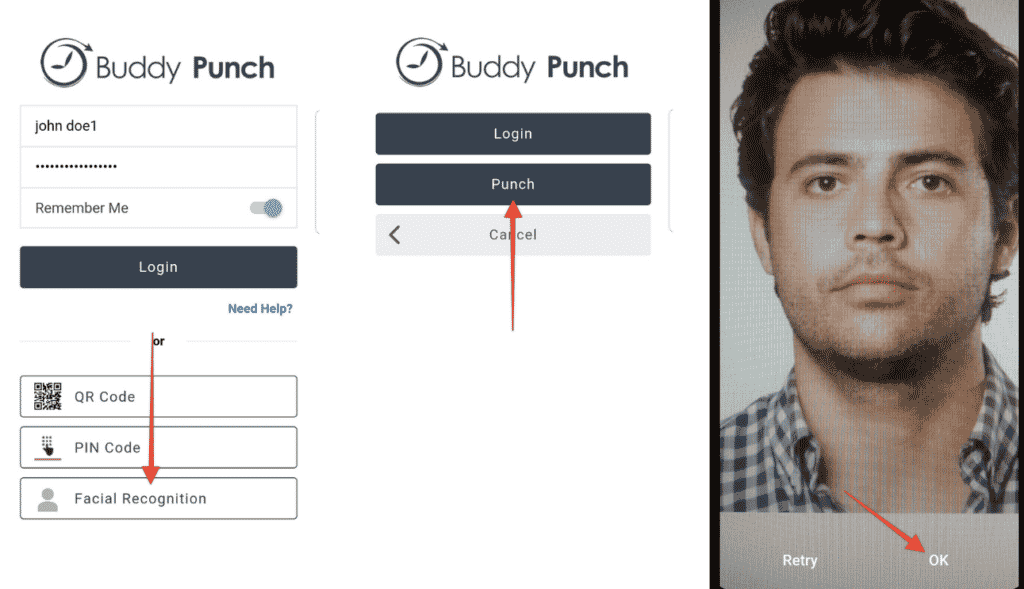
This makes sure they’re at the right place when they start or finish work, which reduces the chances of them reporting time dishonestly.
4. Attendance Monitoring Through Notifications and Locations
With Buddy Punch, you can get notifications when employees start or finish work, which helps you track their attendance right away.
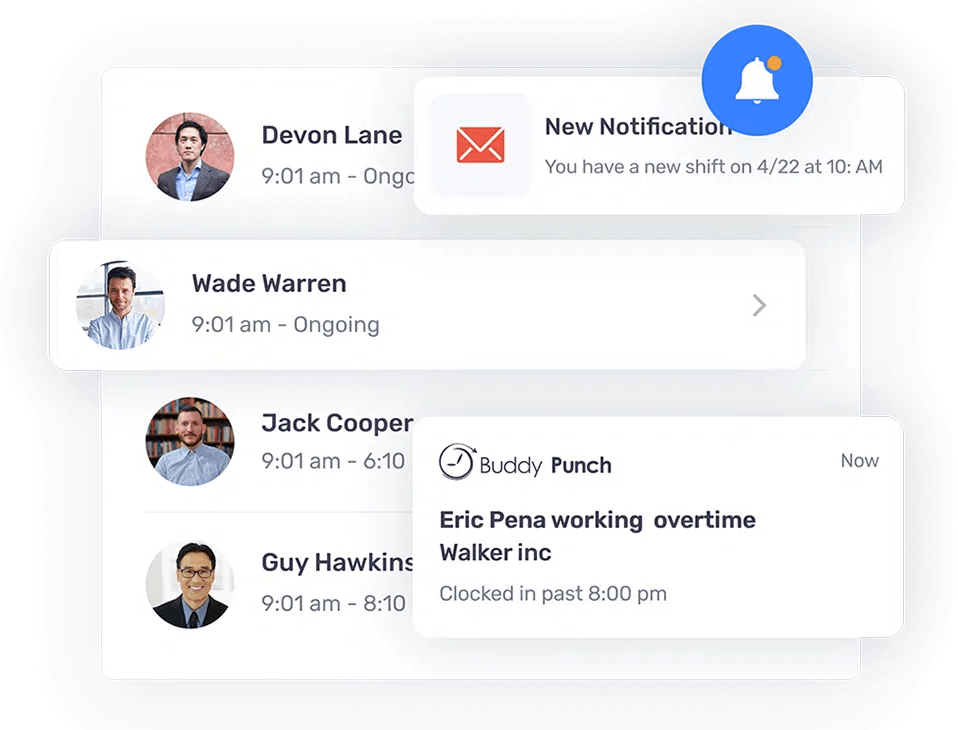
This feature makes sure you know if they’re not sticking to their schedule so you can act quickly.
5. Attendance Tracking Through Job Code Assignment
Job codes, also called department codes, let employers track how much time employees spend on different tasks.

Employees can switch between codes easily during their shifts, and all their time entries are recorded on their time cards and in reports.
6. Single Sign-On (SSO) For Easy Attendance Login
Buddy Punch offers Single Sign-On (SSO) feature for easy login.
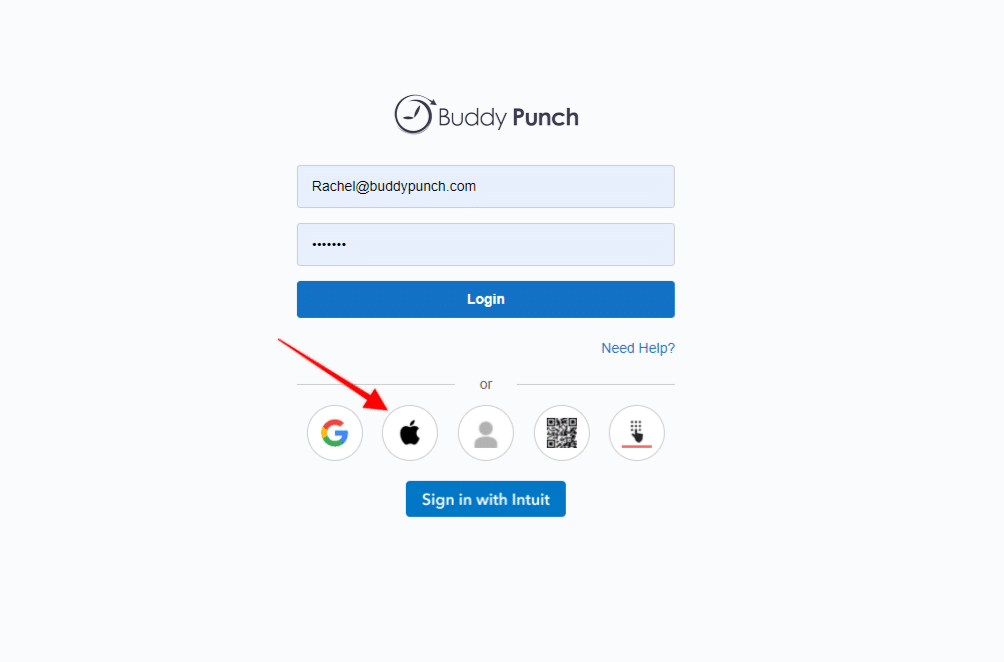
With Buddy Punch, employees can log in to track their attendance without needing to remember lots of passwords.
7. Attendance Tracking Via Text-To-Punch Feature
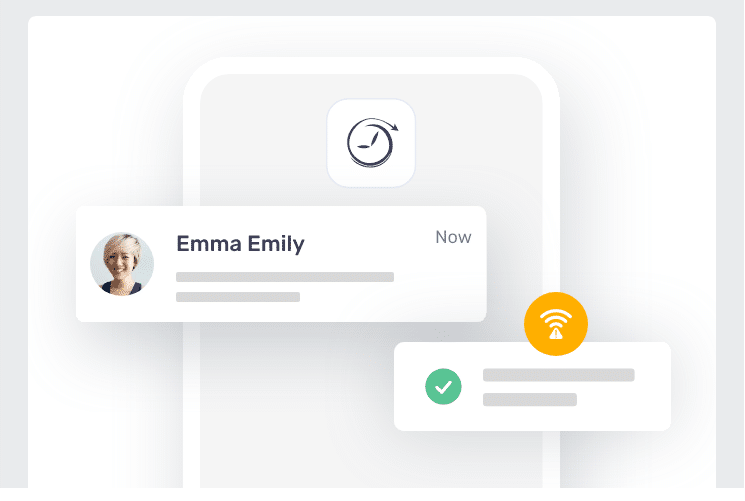
With Buddy Punch’s Text-To-Punch feature, employees can clock in or out instantly, no matter where they are or what device they’re using.
8. GPS Tracking For Remote Attendance Monitoring
GPS tracking is useful for keeping an eye on remote employees’ attendance. It can also stop payroll fraud by giving exact location data for each clock-in.
9. IP Address Locks For Secure Attendance Tracking
IP address locks make sure employees can only clock in or out from certain devices or places, which adds more security to the attendance tracking system.
10. Attendance Management Including PTO, Sick, and Vacation Time
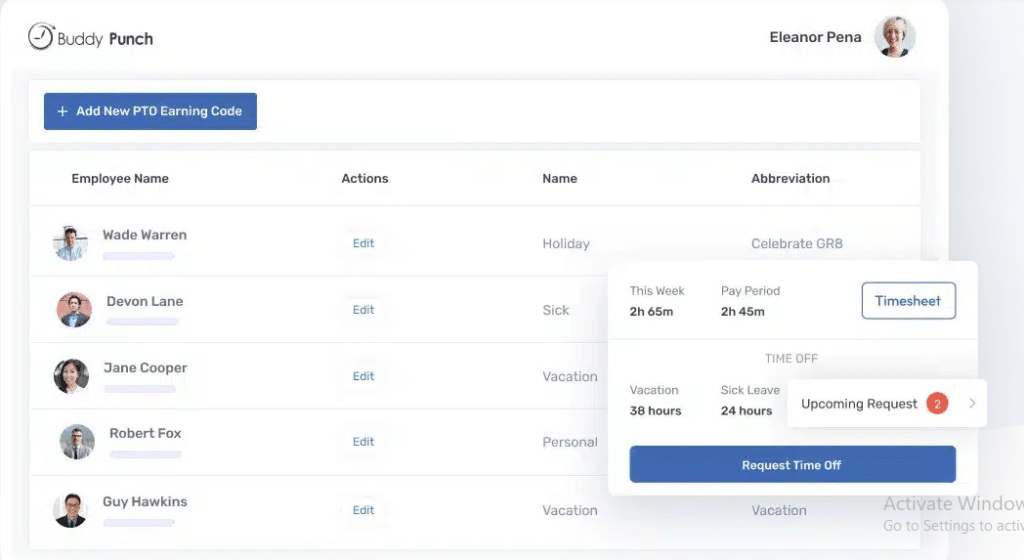
Managing attendance, which includes tracking paid time off (PTO), sick leave, and vacation time, is important for making sure payroll is correct and managing the workforce well.
Buddy Punch keeps track of how much time off employees have earned and used. It also makes it easy to approve or deny time-off requests, which helps avoid scheduling problems.
11. Attendance Reporting For Data Analysis

Attendance reporting gives useful information about how employees attend work, which helps businesses decide how to improve attendance and productivity.
12. Automatic Breaks Deduction From Attendance Records
Buddy Punch makes sure that breaks are counted correctly without needing people to enter them manually. This reduces mistakes and saves time for both employees and managers.
Buddy Punch’s Online Reviews
As of today, Buddy Punch has 4.8 out of 5 stars on Capterra based on its 946 total reviews.

Below, we’ll list just a few reviews that speak to Buddy Punch’s ease of use and great customer support service. (Click here to explore the full list of reviews.)
“We needed a new solution for timekeeping and Buddy Punch came through! Onboarding and integration was so easy. Once I figured out all the setting options, it’s really easy to customize to exactly what you need. Employees love using it because it’s so straight forward to use.”
Click here to read the full review
“BuddyPunch has been very helpful and I am glad my organization made the switch from our previous tracker to BuddyPunch. As mentioned earlier, the ease of use of BuddyPunch is what separates it from a lot of competitors.”
Click here to read the full review
“Easy to clock in from anywhere and still manage how much time you’ve worked in a day. Easily tells you when you’ve gone past 8hrs, and also great for seeing when your team members are clocked in or out.”
Click here to read the full review
Try Buddy Punch for Free
Ready to start a free trial?
No credit card required, all features included.
If you feel that Buddy Punch might be the right fit for your business, sign up for a 14 day free trial (no credit card needed). You can also book a one-on-one demo, or view a pre-recorded demo video
2. Rippling
Rippling is a platform that combines HR and IT management. It helps make employee management easier by simplifying and automating tasks.
The platform has many features to help businesses manage their employees better.
It includes tools to make the onboarding process smoother, like gathering new hire information, setting up accounts, and assigning tasks to make sure new employees start well.
Key Features,
- Employee Onboarding
- Payroll Processing
- Benefits Administration
- Time Tracking
- Compliance Assistance
- Employee Self-Service
- IT Management
- Security and Access Control
- Reporting and Analytics
- Integrations with other HR and IT tools
Rippling has a rating of 4.9 stars out of 5 on Capterra as of the writing date.
It has 3034 reviews on Capterra.
“I use Rippling to monitor all my payroll from my company. I am able to carry my payroll on the go and I use it to present as proof whenever I wish to travel. Navigating around the app is very simple and easy.”
Click here to read the full review.
3. Clockify
Clockify is a tool for tracking time that offers many features to help businesses keep track of their time-related tasks. It’s designed to help both individuals and teams manage their time well.
Key Features,
- Time Tracking
- Project and Task Management
- Reporting and Analytics
- Billable Hours Tracking
- Team Collaboration
- User Permissions and Roles
- Integration with Third-Party Apps
- Mobile Time Tracking
- Invoicing
- Browser Extension
Clockify has 4.7 out of 5 on Capterra as of the writing date.
It has a total of 4788 reviews on Capterra.
“It is a great software for smart working experience. It works very well and it helps you to track time from anywhere.Its flexibility makes it compatible with everyone.collected data by clockify helps me alot to analyze employees performance issues and also create reports.”
Click here to read the full review.
4. eBility Time Tracker
The eBility time tracker helps people and businesses manage time well. It’s useful for keeping track of time, analyzing how time is used, and making time use better.
This helps users be more productive and manage projects better. The tool is flexible and can meet the time management needs of various users, from freelancers to businesses.
Key Features,
- Automated Time Tracking
- Task and Project Management
- Invoicing
- Reporting
- User Permissions
- Mobile Accessibility
- Client Billing
- Integration Capabilities
- Collaboration Tools
- Expense Tracking
Time Tracker has 4.4 stars out of 5 on Capterra as of the writing date.
It has a total of 2992 reviews on Capterra.
“Time tracker has been great for most of my employees to track their hours accurately, as well as give me a way to double check those hours using the mapping feature.”
Click here to read the full review.
5. BambooHR
BambooHR is HR software that helps small and medium-sized companies manage their HR tasks effectively.
It allows HR specialists to easily access and handle employee records. These records can include personal information, contact details, job history, and performance reviews.
Key Features,
- Employee Database
- Applicant Tracking System (ATS)
- Onboarding and Offboarding
- Time and Attendance Tracking
- Performance Management
- Employee Self-Service
- Reporting and Analytics
- Benefits Administration
- Document Management
- Mobile App Access
BambooHR has a rating of 4.6 stars out of 5 on Capterra as of the writing date.
It has 2746 reviews on Capterra.
“Excellent project data management and the Applicant tracking functionalities and easy reporting across several projects the tool is fantastic.”
Click here to read the full review.
Understanding The Impact of Poor Attendance

Poor attendance can have serious consequences in various aspects of life.
Here’s why it matters:
- Education: Missing school affects learning, leading to lower grades and falling behind classmates.
- Work: Absences at work can result in missed opportunities, reduced productivity, and even job loss.
- Health: Chronic absenteeism may indicate underlying health issues and hinder access to medical care.
- Relationships: Unreliability can strain relationships with friends, family, and colleagues.
- Opportunities: Regular attendance opens doors to opportunities for advancement and personal growth.
How Can I Encourage Employees To Buy Into The Attendance Improvement Plan?
To make sure everyone is on board with the attendance improvement plan (AIP), it’s important to communicate well and involve everyone. Ask employees for their ideas and feedback when creating the plan, and be willing to tweak it if necessary.
Provide support to help improve attendance, such as flexible schedules or counseling if needed. Also, acknowledge and reward perfect attendance to motivate others to do the same.
What Are Some Signs That The Attendance Improvement Plan Is Working?
Signs that an attendance improvement plan is working include:
- Being On Time: Employees are showing up to work on time or even early more often, showing they understand and are committed to their work schedule.
- Better Morale: Employees seem happier and more involved in their work, possibly because they feel more responsible and appreciated with the attendance plan.
- Improved Teamwork: Team dynamics improve, like better teamwork and clear communication, which can mean employees are more engaged and present at work.
- More Productivity: With fewer absences and late arrivals, overall productivity can go up because more employees are there to finish tasks and meet deadlines.
- Employee Feedback: Employees might like the changes and feel more motivated to come to work because of the program’s rewards or support.
How Can I Celebrate and Reward Good Attendance Among My Employees?
Celebrating and rewarding employees who improve their attendance is a good way to encourage them and make them feel good about their work.
Giving rewards like gift cards, extra time off with pay, or small bonuses can also encourage employees to keep up their good attendance.
Publicly recognizing and thanking employees for coming to work regularly can help create a positive work environment.
Ready to give Buddy Punch a try?
For free trial, no credit card required.
How Can a Performance Improvement Plan for Attendance Benefit Employees and Employers?
A Performance Improvement Plan (PIP) for attendance can benefit both employees and employers in several ways.
Benefits for Employees
Clear Expectations: Provides clear guidelines and expectations regarding attendance, helping employees understand what is required of them.
Opportunity for Improvement: Gives employees a structured opportunity to improve their attendance and performance before facing serious consequences such as termination.
Professional Development: Can include training and support resources to help employees overcome barriers to attendance, which can contribute to their overall professional development.
Recognition of Challenges: Allows employees to communicate any challenges they may be facing that impact their attendance.
Career Advancement: Successfully completing a PIP for attendance can demonstrate a commitment to improvement, which may enhance opportunities for career advancement within the organization.
Benefits for Employers
Increased Productivity: Improved attendance leads to increased productivity as employees are present and engaged in their work.
Retention of Talent: Helps in retaining talented employees by providing them with support and guidance to address attendance issues.
Legal Compliance: Demonstrates efforts to comply with employment laws and regulations, which can help mitigate legal risks associated with termination.
Improved Morale: Creating a fair and supportive process for addressing attendance issues can boost morale among employees, as they feel valued and supported by their employer.
Cost Savings: Reduces costs associated with absenteeism, such as overtime pay for covering shifts or hiring temporary replacements.
How Does Implementing a PIP for Attendance Address Absenteeism?
A Performance Improvement Plan (PIP) for attendance is necessary in addressing employee attendance issues such as excessive absenteeism and unscheduled absences.
By implementing a PIP, employers can establish clear rules and consequences regarding employee absenteeism, forcing accountability and promoting a culture of punctuality in the workplace.
The PIP sets specific goals for attendance improvement, aiming to reduce employee absences and enhance overall attendance rates.
Through regular check-ins and progress checks, employers can monitor employees’ adherence to the plan and provide necessary support and guidance.
This may include counseling sessions or additional training to address underlying issues contributing to absenteeism, such as employee behavior or health concerns covered under the Family and Medical Leave Act (FMLA) or the Americans with Disabilities Act (ADA).
Moreover, the PIP ensures that formal documents or documentation of employee attendance issues is appropriately maintained in their personnel file, including records of employee signatures acknowledging the plan’s terms and conditions.
By promoting open communication and offering supportive measures, a PIP serves as a proactive approach to managing employee attendance problems.
It eventually leads to improved performance and workplace satisfaction.
What Steps Should Be Included in an Action Plan for Absenteeism at Work?
To reduce absenteeism, here’s what you can do:
- Figure out why people are absent by asking them or doing surveys.
- Make clear rules about attendance and tell everyone about them.
- Help employees by giving them flexible schedules or support programs.
- Praise employees who show up regularly and give them feedback.
- Keep an eye on attendance numbers to see if there are any problems.
- Teach managers how to handle absenteeism.
- Keep checking and changing the plan to make sure it keeps working well.
How Can Employers Create a Plan for Improvement for Tardiness? Proven Methods to Improve Attendance at Work

Employers can help improve punctuality among their staff by following these proven methods to improve attendance at work:
1. Clear Attendance Policies: Make sure everyone knows the attendance rules, like when to show up and what happens if they’re late.
2. Flexible Scheduling Options: Give employees options like different start times or working from home to make it easier for them to be on time.
3. Time Tracking Systems: Use systems like fingerprint scanners or software programs to record when people arrive, so you can see if there’s a pattern of lateness.
4. Progressive Discipline: Start with warnings for being late, then give written warnings, suspend if needed, and if it keeps happening, consider letting them go.
5. Positive Reinforcement: Reward people who are always on time with bonuses or extra time off to encourage everyone to be punctual.
6. Employee Assistance Programs (EAPs): Offer counseling or help for employees who are struggling with personal issues that affect their punctuality.
7. Training and Development: Teach time management and organization to help people manage their time better.
8. Mentorship and Coaching: Pair people who struggle with being on time with someone who can help them get better.
9. Performance Reviews: Keep track of attendance and talk about it during performance reviews to help people improve.
10. Collaborative Problem-Solving: Talk to employees to find out why they’re late and come up with solutions together to fix the problem.
What Should a Corrective Action Plan (CAP) for Attendance Include?

A Corrective Action Plan (CAP) for attendance typically outlines steps an employee must take to address recurring attendance issues.
The plan involves:
- Setting clear attendance expectations
- Identifying root causes of absenteeism
- Implementing strategies for improvement (such as flexible scheduling or telecommuting options)
- Establishing consequences for continued non-compliance.
It’s important to personalize the CAP to the employee’s circumstances, providing support and resources as needed while also holding them accountable for attendance.
Regular feedback and monitoring are crucial to ensure progress and adherence to the plan.
Can You Provide a Sample Corrective Action Plan for Attendance?
Here’s a template version of the Corrective Action Plan for attendance:
| Title: Attendance Improvement Plan Objective: [Insert objective statement here, e.g., “To improve attendance and punctuality to meet company standards and expectations.”] Steps: 1. Schedule a Meeting: Schedule a meeting with the employee to discuss the attendance issue. 2. Communicate Expectations: Clearly communicate the employee attendance policy and expectations to the employee. 3. Identify Reasons: Identify any underlying reasons for poor attendance and offer support if needed. 4. Set Goals: Set specific attendance goals and timelines for improvement. 5. Implement Tracking: Implement a tracking system to monitor attendance regularly. 6. Provide Support: Provide ongoing feedback and support to the employee to help them improve attendance. 7. Offer Incentives: Offer incentives for meeting attendance goals. 8. Review Progress: Review progress regularly and adjust the plan as necessary. Conclusion: By implementing this plan, we aim to foster a culture of accountability and reliability within the team. |
What Are Attendance Goals for Employees, and How Can They Be Established?

Attendance goals for employees are targets set to ensure consistent and punctual attendance at work.
Here’s how they can be established:
- Define Clear Expectations: Clearly communicate the company’s employee attendance policy and expectations to all employees.
- Set Quantifiable Targets: Establish specific attendance metrics such as percentage of punctuality and number of absences allowed.
- Consider Industry Standards: Benchmark attendance goals against industry standards or best practices.
- Feedback and Monitoring: Regularly provide feedback on attendance performance issues and monitor progress towards goals.
- Incentives and Rewards: Offer incentives or rewards for achieving or exceeding attendance goals, fostering motivation.
- Flexibility: Allow for reasonable flexibility to accommodate unforeseen circumstances while maintaining accountability.
What Are Some Examples of Realistic Attendance Goals for Employees?
Realistic attendance goals for employees can vary depending on the industry, company culture, and job responsibilities.
Some examples might include:
- Achieving 95% attendance or higher over a quarter.
- Limiting unplanned absences to no more than 5 days per year.
- Ensuring punctuality by arriving on time for scheduled shifts at least 95% of the time.
- Participating in mandatory training sessions or meetings with no more than 1 absence per quarter.
- Maintaining consistent attendance during critical periods such as project deadlines or seasonal peaks.
- Collaborating with team members to cover shifts during emergencies or unexpected absences.
How Can Employers Set and Track Attendance Goals Effectively?

Buddy Punch is a simple and user-friendly time tracking software that helps employers set and track attendance goals effectively.
By clearly communicating attendance objectives to employees, employers can use Buddy Punch’s features to monitor attendance patterns, track punctuality, and manage absences with ease.
Buddy Punch has customizable reporting tools and an intuitive interface that allows employers to analyze attendance data quickly, identify trends, and address any issues promptly. The software also automates notifications and reminders to help employees stay accountable, which fosters a culture of punctuality and reliability in the workplace.
With Buddy Punch, employers can streamline attendance management and set attainable attendance goals with minimal effort.
Ready to give Buddy Punch a try?
For free trial, no credit card required.
Is it the Duty of HR (Human Resources) to take Disciplinary Actions based on Business’s Employee Attendance Policy?
Yes, HR can handle disciplinary actions for not following the attendance rules at work.
They make sure everyone follows the company’s policies, including showing up on time. This means keeping track of who’s there and dealing with it if someone isn’t following the rules.
By doing this fairly, HR keeps the workplace running smoothly and treats everyone equally. They might also work with managers to sort out attendance problems while keeping the company’s values in mind.
In cases of repeated no-shows or tardiness, HR may initiate further disciplinary action to address the issue effectively. This could involve implementing a time frame for improvement and providing a verbal warning to the employee regarding their attendance.
By integrating these measures into the workflow, HR ensures a proactive approach to maintaining punctuality and accountability within the organization.
What Does Employee Engagement Have To Do With Attendance?

When employees are engaged, it means they’re really into their work and feel like they matter.
When people feel this way, they’re more likely to show up to work regularly because they enjoy what they do and care about how well things go.
Also, when a company encourages engagement and appreciates when employees show up, it makes everyone feel even more connected.
So, if a company focuses on keeping employees engaged, it can help make sure people come to work regularly, which makes the team stronger and more productive.
However, maintaining high attendance rates isn’t solely about engagement. It also involves developing and implementing policies that promote a healthy work-life balance and prioritize employee well-being.
This is where an employee handbook becomes invaluable, outlining clear expectations regarding work hours, addressing absenteeism, and providing resources for enhancing well-being.
Conclusion, Why Is Consistent Attendance Integral to Workplace Success?
Showing up to work regularly is really important for doing well at your job.
It proves that you’re dependable.
It helps build trust with your coworkers and employers, and makes sure you finish your work on time.
Lastly consistent attendance keeps the team’s productivity up so the company can reach its goals ASAP.



